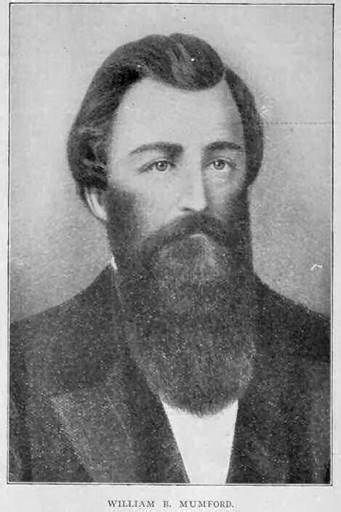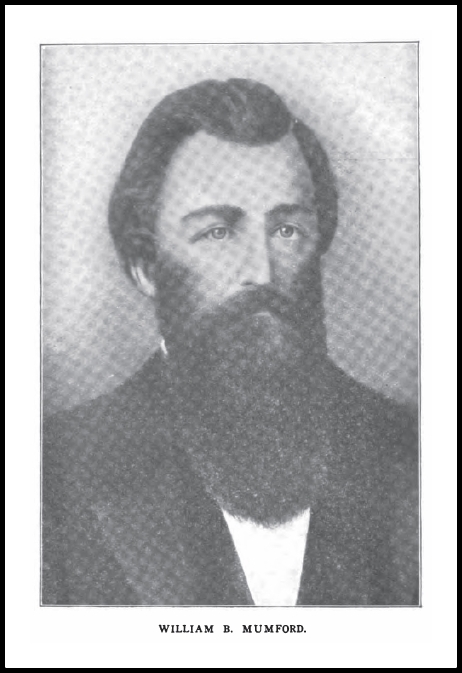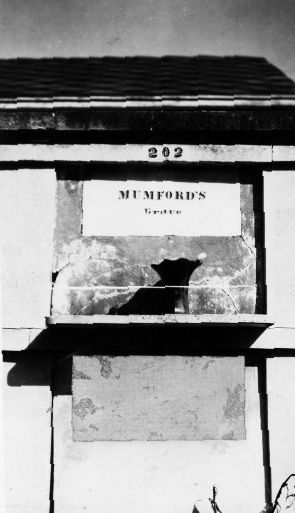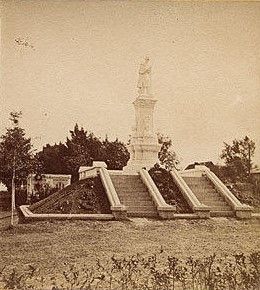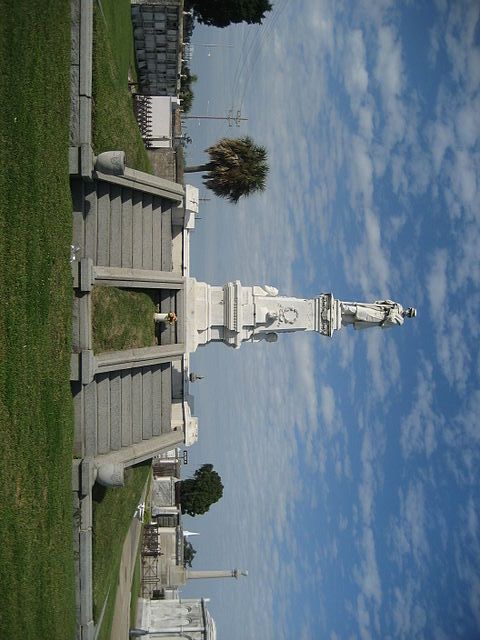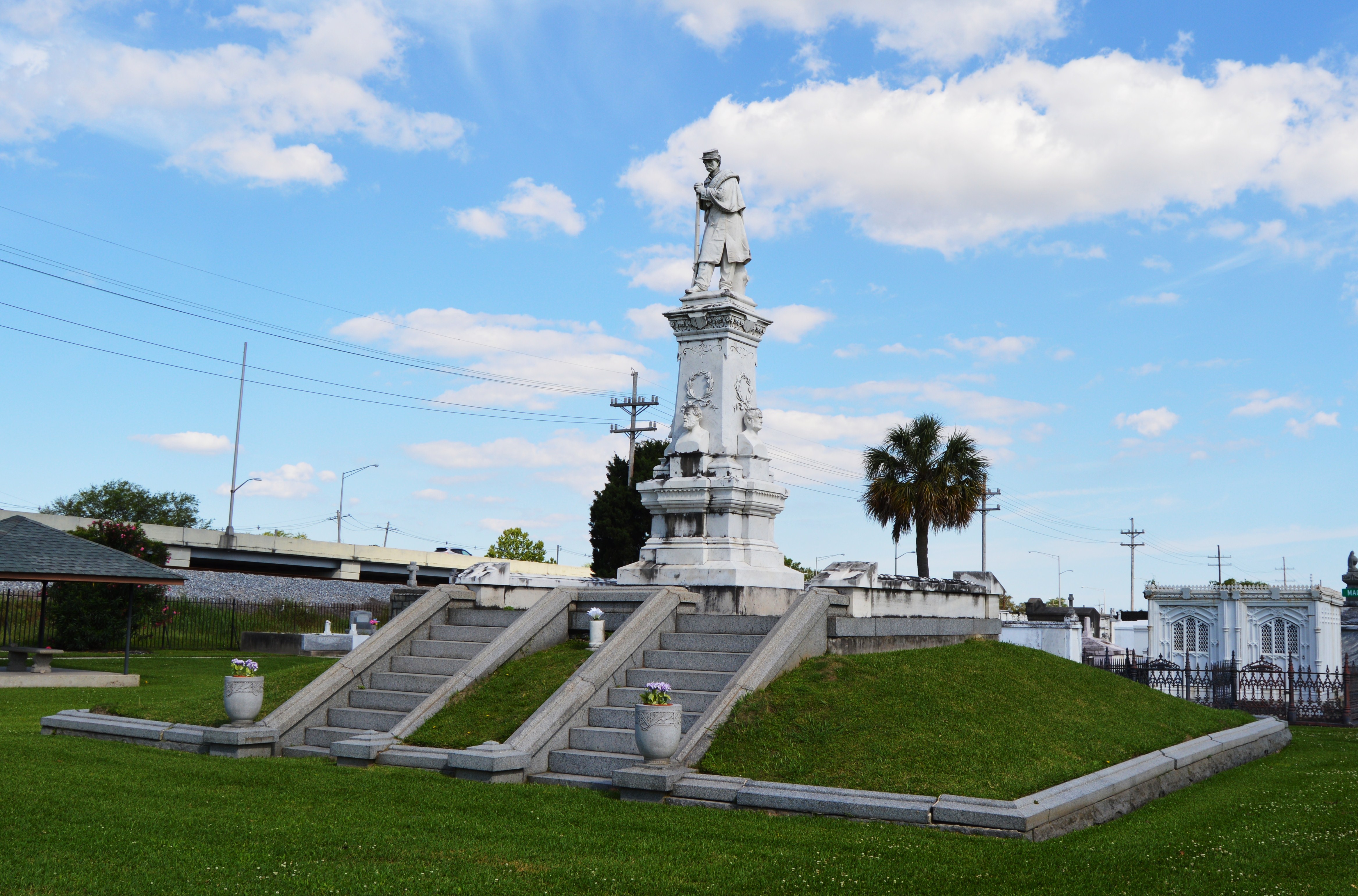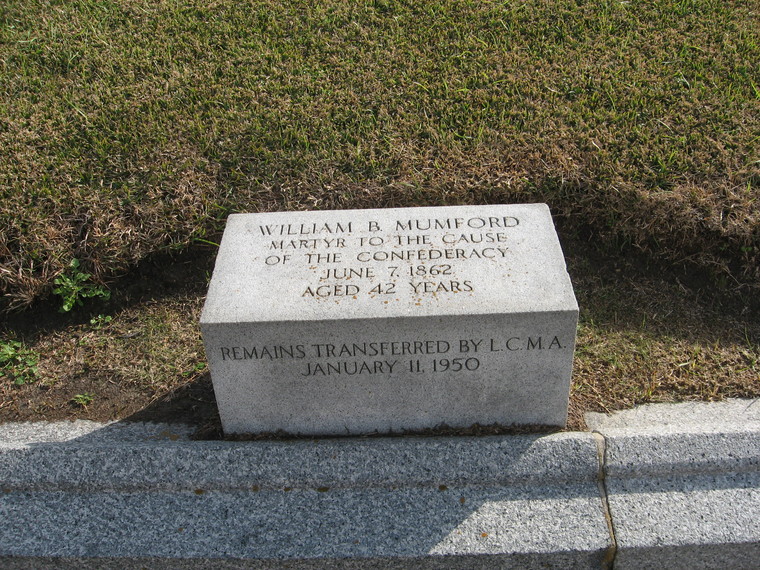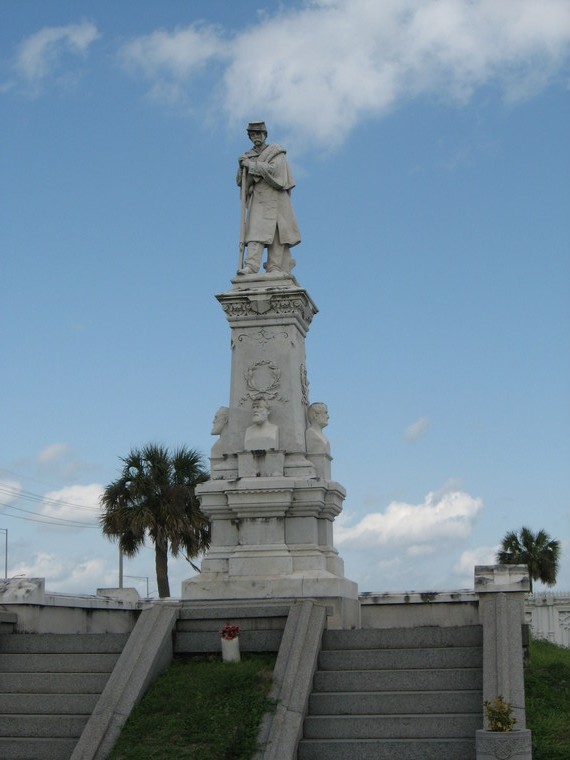As Union ships approached New Orleans, Commander David Farragut ordered Confederate flags removed from city buildings and tried to secure a surrender from Mayor John Monroe. On April 26, 1862 Union Captain Henry Morris took it upon himself to have his marines raise the U.S. flag over the mint, even though the city had not yet officially surrendered.
William Mumford, who, according to his own words, was ‘compelled by the highest act of patriotism', tore down the U.S. flag and intended to deliver it to City Hall, but the crowd tore it from his hands and shredded it. Union General Benjamin "Beast" Butler, commander of the ground forces, heard about the incident and decided to make an example of Mumford. He was arrested, court-martialed, and hanged for treason, leaving behind a wife and three children whose pleas for leniency Butler ignored.
After Mumford was hanged, Confederate General Robert E. Lee demanded an explanation as to how someone could be executed for a crime that was committed prior to the city's surrender. Confederate President Jefferson Davis issued a statement proclaiming Butler a criminal worthy of hanging.
William Bruce Mumford was originally buried in a family vault in Cypress Grove Cemetery in New Orleans under a simple card bearing his name, handwritten by his wife. This card was removed by order of the occupying federal troops. Mrs. Mumford then had a marble marker inscribed with the words "Mumford's Grave" for his tomb. In January 1950 Mumford's remains were transferred to the Confederate Monument at Greenwood Cemetery by the Ladies' Confederate Memorial Association.
~~~~~~~~~~~~~~~~~~~~~~~~~~~~~~~~~~~~~~~~~~~~~~~~~~~~~~~~~~
From: The New York Herald. (New York [N.Y.]), 19 June 1862, P.2, Col 1. (Also, see at: https://chroniclingamerica.loc.gov/lccn/sn83030313/1862-06-19/ed-1/seq-2/)
The following brief sketch of the life of Mumford is mostly from his own lips. He was born of a very respectable family, in Arslow county, North Carolina, on the 5th of December, 1819, and was consequently, at the time of his death, in the 43d year of his age. When but three years of age his father died, leaving him about fifty thousand dollars. While yet a boy he went to Florida, and remained there during the Florida war, returning to his home in 1837. In 1842 he left his home and went up the Red river, where he married an estimable lady, acquiring considerable property with her. In 1844 he came to this city, where he remained until 1846, when he went to Mexico as an orderly sergeant in the Third Louisiana regiment of General Persifer F. Smith’s brigade. Shortly after he arrived in Mexico he broke his leg, got sick and was obliged to be discharged from service. Since then he has followed gambling as a profession and was so noted for his proficiency at cards that planters would come to the city and furnish him with money to play with, giving him half of all he could win. He was wild as a boy, and in manhood squandered his own and his wife’s fortune, leaving his family at his death almost penniless. He was uneducated, but not unintelligent, and I think his impulses were generally kindly. In person he was of middle height, about five feet seven, broad frame, but quite thin, dark complexion and eyes, straight, glossy black hair, and a long, flowing brown beard and moustache. His face was deeply pitted with smallpox. Before his death he requested that his beard should not be cut. On the morning of his execution he was dressed very carefully and neatly in a black and apparently new suit, white shirt and collar, and a black felt hat.
Above information provided by member Ron Collins (#14149965)∼On April 25, 1862, as Union Navy ships approached Confederate New Orleans, Commodore David Farragut ordered two officers to send a message to Mayor John T. Monroe requesting removal of Confederate flags from the local customhouse, mint and city hall and their replacement with U.S. flags. Monroe refused, claiming it was beyond his jurisdiction. On April 26, Capt. Henry W. Morris sent ashore Marines from the USS Pocahontas to raise the U.S. flag over the mint. Morris did so without any order from Farragut, who was still trying to receive an official surrender from the mayor.
As the Marines raised the flag, a number of locals gathered around in anger. The Marines told them that the Pocahontas would fire on anyone attempting to remove the flag. However, a group of seven individuals, including Mumford, decided to remove the flag from the mint. The Pocahontas fired and Mumford was injured by a flying piece of brick. With cheers from local onlookers, he carried the flag to the mayor at city hall, but onlookers tore at it as he walked, reducing it to a stub.
Three days later Union Army Maj. Gen. Benjamin Butler, the commander of the Union ground forces, heard about the incident and decided to arrest and punish Mumford. When the Union Army occupied the city on May 1, Mumford was arrested and charged with "high crimes and misdemeanors against the laws of the United States, and the peace and dignity thereof and the Law Martial." On May 30, he was tried before a military tribunal and convicted, even though there was no clear attempt to determine whether the city was actually occupied when the event occurred.
On June 5, Butler issued the following Special Order No. 70:
William B. Mumford, a citizen of New Orleans, having been convicted before a military commission of treason and an overt act thereof, tearing down the United States flag from a public building of the United States, after said flag was placed there by Commodore Farragut, of the United States navy: It is ordered that he be executed according to sentence of said military commission on Saturday, June 7, inst., between the hours of 8 a.m. and 12 a.m. under the directions of the provost-marshal of the District of New Orleans, and for so doing this shall be his sufficient warrant.
On June 7, a little before noon, Mumford was taken to be hanged in the courtyard of the mint itself, a place that Butler had decided "according to the Spanish custom" would be the ideal place. Many people came to the spot, and Mumford was allowed to give a final speech in which he spoke of his patriotism for the Confederacy and his love for what he considered the true meaning of the U.S. flag, a symbol he had fought under in the Seminole Wars and the Mexican–American War.
After he was hanged, Confederate Governor of Louisiana Thomas Overton Moore issued a statement on June 18th declaring Mumford a hero and a model. Robert E. Lee demanded that Union General Henry Wager Halleck explain how execution could have occurred for a crime committed before New Orleans was occupied. Confederate President Jefferson Davis issued a proclamation stating that Benjamin Butler should be considered a criminal and worthy of hanging. Later on Butler assisted Mumford's wife and helped her find a job in Washington.
Mumford was originally buried in a vault in Cypress Grove Cemetery. His remains were transferred to the Confederate Monument at Greenwood Cemetery by the Ladies' Confederate Memorial Association on January 11, 1950.
As Union ships approached New Orleans, Commander David Farragut ordered Confederate flags removed from city buildings and tried to secure a surrender from Mayor John Monroe. On April 26, 1862 Union Captain Henry Morris took it upon himself to have his marines raise the U.S. flag over the mint, even though the city had not yet officially surrendered.
William Mumford, who, according to his own words, was ‘compelled by the highest act of patriotism', tore down the U.S. flag and intended to deliver it to City Hall, but the crowd tore it from his hands and shredded it. Union General Benjamin "Beast" Butler, commander of the ground forces, heard about the incident and decided to make an example of Mumford. He was arrested, court-martialed, and hanged for treason, leaving behind a wife and three children whose pleas for leniency Butler ignored.
After Mumford was hanged, Confederate General Robert E. Lee demanded an explanation as to how someone could be executed for a crime that was committed prior to the city's surrender. Confederate President Jefferson Davis issued a statement proclaiming Butler a criminal worthy of hanging.
William Bruce Mumford was originally buried in a family vault in Cypress Grove Cemetery in New Orleans under a simple card bearing his name, handwritten by his wife. This card was removed by order of the occupying federal troops. Mrs. Mumford then had a marble marker inscribed with the words "Mumford's Grave" for his tomb. In January 1950 Mumford's remains were transferred to the Confederate Monument at Greenwood Cemetery by the Ladies' Confederate Memorial Association.
~~~~~~~~~~~~~~~~~~~~~~~~~~~~~~~~~~~~~~~~~~~~~~~~~~~~~~~~~~
From: The New York Herald. (New York [N.Y.]), 19 June 1862, P.2, Col 1. (Also, see at: https://chroniclingamerica.loc.gov/lccn/sn83030313/1862-06-19/ed-1/seq-2/)
The following brief sketch of the life of Mumford is mostly from his own lips. He was born of a very respectable family, in Arslow county, North Carolina, on the 5th of December, 1819, and was consequently, at the time of his death, in the 43d year of his age. When but three years of age his father died, leaving him about fifty thousand dollars. While yet a boy he went to Florida, and remained there during the Florida war, returning to his home in 1837. In 1842 he left his home and went up the Red river, where he married an estimable lady, acquiring considerable property with her. In 1844 he came to this city, where he remained until 1846, when he went to Mexico as an orderly sergeant in the Third Louisiana regiment of General Persifer F. Smith’s brigade. Shortly after he arrived in Mexico he broke his leg, got sick and was obliged to be discharged from service. Since then he has followed gambling as a profession and was so noted for his proficiency at cards that planters would come to the city and furnish him with money to play with, giving him half of all he could win. He was wild as a boy, and in manhood squandered his own and his wife’s fortune, leaving his family at his death almost penniless. He was uneducated, but not unintelligent, and I think his impulses were generally kindly. In person he was of middle height, about five feet seven, broad frame, but quite thin, dark complexion and eyes, straight, glossy black hair, and a long, flowing brown beard and moustache. His face was deeply pitted with smallpox. Before his death he requested that his beard should not be cut. On the morning of his execution he was dressed very carefully and neatly in a black and apparently new suit, white shirt and collar, and a black felt hat.
Above information provided by member Ron Collins (#14149965)∼On April 25, 1862, as Union Navy ships approached Confederate New Orleans, Commodore David Farragut ordered two officers to send a message to Mayor John T. Monroe requesting removal of Confederate flags from the local customhouse, mint and city hall and their replacement with U.S. flags. Monroe refused, claiming it was beyond his jurisdiction. On April 26, Capt. Henry W. Morris sent ashore Marines from the USS Pocahontas to raise the U.S. flag over the mint. Morris did so without any order from Farragut, who was still trying to receive an official surrender from the mayor.
As the Marines raised the flag, a number of locals gathered around in anger. The Marines told them that the Pocahontas would fire on anyone attempting to remove the flag. However, a group of seven individuals, including Mumford, decided to remove the flag from the mint. The Pocahontas fired and Mumford was injured by a flying piece of brick. With cheers from local onlookers, he carried the flag to the mayor at city hall, but onlookers tore at it as he walked, reducing it to a stub.
Three days later Union Army Maj. Gen. Benjamin Butler, the commander of the Union ground forces, heard about the incident and decided to arrest and punish Mumford. When the Union Army occupied the city on May 1, Mumford was arrested and charged with "high crimes and misdemeanors against the laws of the United States, and the peace and dignity thereof and the Law Martial." On May 30, he was tried before a military tribunal and convicted, even though there was no clear attempt to determine whether the city was actually occupied when the event occurred.
On June 5, Butler issued the following Special Order No. 70:
William B. Mumford, a citizen of New Orleans, having been convicted before a military commission of treason and an overt act thereof, tearing down the United States flag from a public building of the United States, after said flag was placed there by Commodore Farragut, of the United States navy: It is ordered that he be executed according to sentence of said military commission on Saturday, June 7, inst., between the hours of 8 a.m. and 12 a.m. under the directions of the provost-marshal of the District of New Orleans, and for so doing this shall be his sufficient warrant.
On June 7, a little before noon, Mumford was taken to be hanged in the courtyard of the mint itself, a place that Butler had decided "according to the Spanish custom" would be the ideal place. Many people came to the spot, and Mumford was allowed to give a final speech in which he spoke of his patriotism for the Confederacy and his love for what he considered the true meaning of the U.S. flag, a symbol he had fought under in the Seminole Wars and the Mexican–American War.
After he was hanged, Confederate Governor of Louisiana Thomas Overton Moore issued a statement on June 18th declaring Mumford a hero and a model. Robert E. Lee demanded that Union General Henry Wager Halleck explain how execution could have occurred for a crime committed before New Orleans was occupied. Confederate President Jefferson Davis issued a proclamation stating that Benjamin Butler should be considered a criminal and worthy of hanging. Later on Butler assisted Mumford's wife and helped her find a job in Washington.
Mumford was originally buried in a vault in Cypress Grove Cemetery. His remains were transferred to the Confederate Monument at Greenwood Cemetery by the Ladies' Confederate Memorial Association on January 11, 1950.
Inscription
Martyr to the Cause of the Confederacy
Aged 42 Years
Remains transferred by L.C.M.A.
January 11, 1950
Gravesite Details
Age, Name on Plot, Date of Burial 1/11/1950, Ref: Cemetery Records




